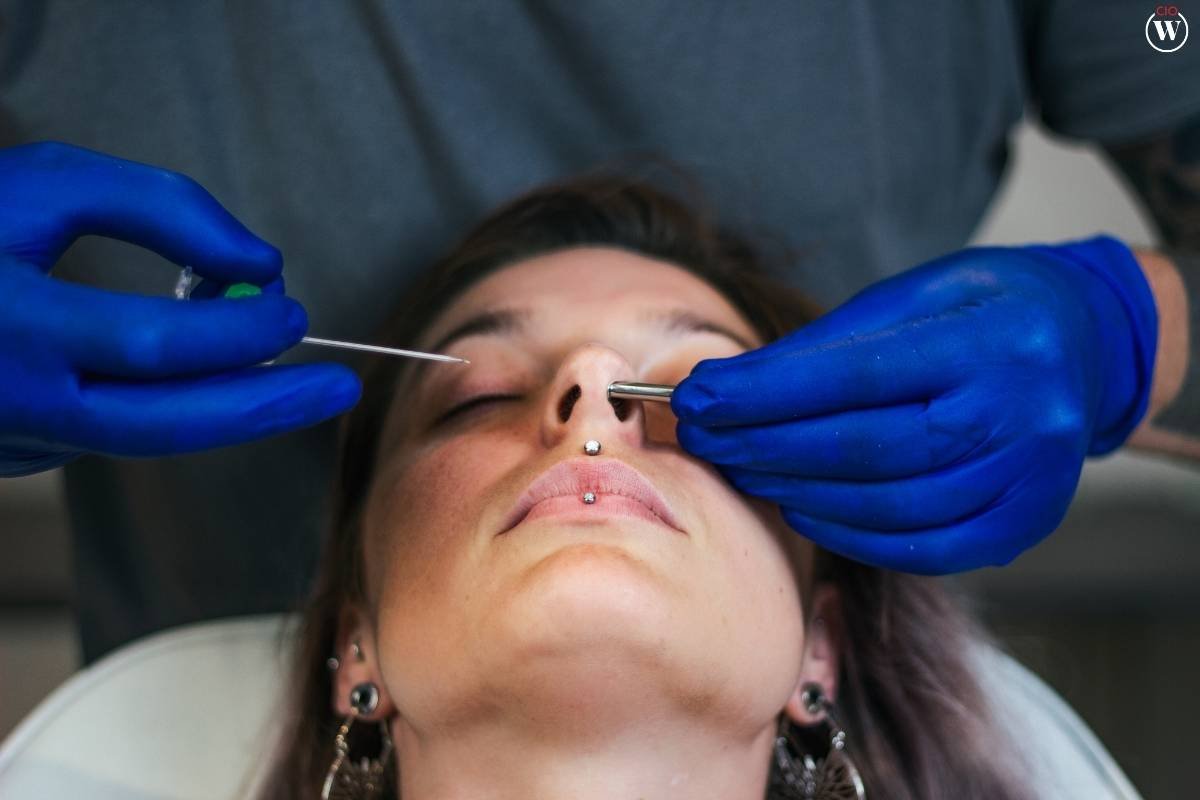Source – Cosmopolitan
Body Modifications have been a significant part of human culture for centuries, serving as a form of self-expression, tradition, or simply as a fashion statement. Among the myriad of options, nose piercings and septum piercings stand out as two popular choices. While both involve piercing the nose, they have distinct characteristics that set them apart. In this comprehensive guide, we’ll delve into the world of Nose Piercing vs. Septum Piercing, exploring their differences, similarities, styles, aftercare, and more.
Understanding Nose Piercing
Nose piercing, as the name suggests, involves piercing the nostril or the area surrounding it. This form of body modification has a rich history, dating back centuries and spanning various cultures worldwide. In contemporary society, nose piercings have become a mainstream fashion trend, embraced by people of diverse backgrounds.
Styles of Nose Piercing:
- Nostril Piercing: This is the most common form of nose piercing, where a hole is made through the nostril. It can be positioned anywhere along the curve of the nostril, offering versatility in placement.
- High Nostril Piercing: As the name implies, this piercing is done slightly higher on the nose compared to the standard nostril piercing. It offers a unique aesthetic and allows for the adornment of both nostrils.
- Bridge Piercing: This piercing is placed horizontally across the bridge of the nose. It’s a bold choice that creates a striking visual effect.
- Double Nostril Piercing: This style involves piercing both nostrils symmetrically, creating a balanced and visually appealing look. It’s a popular choice for those looking to add a bit of symmetry to their facial piercings.
- L-Shaped Nose Stud: Instead of a traditional straight stud, some people opt for an L-shaped nose stud, which sits more securely in the nostril. This style is ideal for those concerned about their jewelry getting caught on clothing or hair.

Understanding Septum Piercing
Septum piercing involves piercing the thin strip of tissue between the nostrils, known as the septum. This type of piercing has gained popularity in recent years, particularly among those seeking a more edgy or unconventional look. This is an important point to consider in the debate between nose piercing vs. septum piercing.
Styles of Septum Piercing:
- Standard Septum Piercing: This involves piercing the septum at its thinnest point, typically near the bottom of the nose. It allows for the insertion of a variety of jewelry styles, from captive bead rings to circular barbells.
- High Septum Piercing: Similar to the high nostril piercing, this style involves piercing the septum higher up, closer to the tip of the nose. It’s a bold choice that can be adorned with intricate jewelry for added flair.
- Bull Ring: The bull ring style involves wearing a large, circular piece of jewelry reminiscent of a bull’s nose ring. It’s a bold and eye-catching choice that makes a statement.
- Clicker Rings: Clicker rings are specially designed for septum piercings and feature a hinged closure mechanism that makes them easy to insert and remove. They come in various designs, including intricate patterns and gemstone embellishments.
Nose Piercing vs. Septum Piercing: Differences
1. Location:
The primary difference between nose piercing and septum piercing lies in their location. Nose piercing involves piercing the nostril or surrounding area, while septum piercing targets the thin strip of tissue between the nostrils.
2. Aesthetic Appeal:
Nose piercings are often seen as more subtle and versatile, allowing for various styles and placements to suit individual preferences. Septum piercings, on the other hand, are typically more noticeable and can add a bold, edgy element to one’s appearance.
3. Pain Level:

Pain tolerance varies from person to person, but generally, septum piercings tend to be more painful than nose piercings. This is due to the sensitivity of the tissue in the septum area.
4. Visibility:
While nose piercings are often visible from the front, septum piercings can be hidden easily by flipping the jewelry up into the nostrils. This versatility allows individuals to choose when to showcase their piercing, making it a more discreet option for certain occasions or environments.
5. Cultural Significance:
Nose piercings have deep cultural significance in many societies, representing rites of passage, religious beliefs, or cultural traditions. Septum piercings, while also holding cultural significance in some communities, are often more closely associated with contemporary fashion and style trends.
Nose Piercing vs. Septum Piercing: Similarities
1. Healing Time:
Both nose piercings and septum piercings require similar healing times, typically ranging from 6 to 12 weeks. During this period, proper aftercare is essential to prevent infection and promote healing.
2. Aftercare:
Proper aftercare is crucial for both nose and septum piercings to minimize the risk of infection and ensure optimal healing. This includes cleaning the piercing with saline solution, avoiding touching it with dirty hands, and refraining from changing the jewelry too soon.
3. Jewelry Options:

Both nose piercings and septum piercings offer a wide range of jewelry options to suit individual style preferences. From simple studs to elaborate hoops, there’s something for everyone to express their unique personality.
4. Risk of Infection:
Both nose piercings and septum piercings carry a risk of infection if proper aftercare practices are not followed. Symptoms of infection include redness, swelling, pain, and discharge. It’s essential to seek medical attention if signs of infection occur.
5. Healing Challenges:
Both nose piercings and septum piercings may face challenges during the healing process, such as irritation from clothing or accidental trauma. It’s important to be patient and diligent with aftercare routines to minimize complications and promote healing.
Conclusion:
The debate between nose piercing vs. septum piercing offers individuals different means of self-expression and style. While they share similarities in terms of healing time, aftercare, and jewelry options, they also have distinct differences in location, aesthetic appeal, and pain level. Whether you opt for a subtle nose piercing or a bold septum piercing, it’s important to research thoroughly, choose a reputable piercer, and prioritize proper aftercare to ensure a safe and successful piercing experience.









